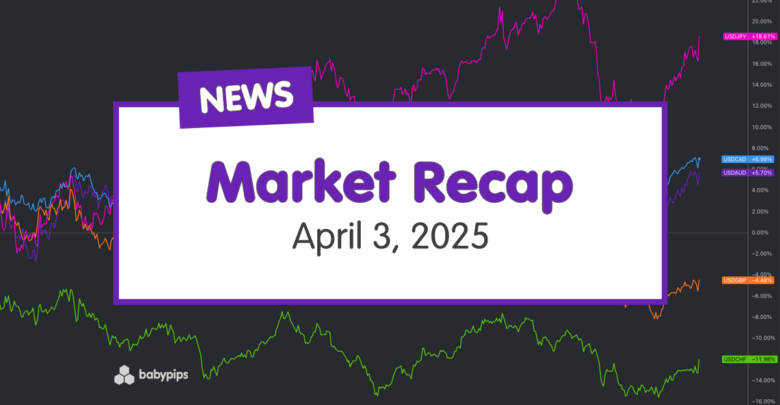
Risk assets and the U.S. dollar barely stood a chance during the aftermath of Trump’s “Liberation Day” tariffs announcements, as trade war shots were fired by targeted economies, further clouding the global growth outlook.
Here are the latest developments you need to take note of:
Headlines:
- Australia S&P Global Services PMI Final for March 2025: 51.6 (51.2 forecast; 50.8 previous)
- Australia Balance of Trade for February 2025: 2.97B (5.1B forecast; 5.62B previous); Exports: -3.6% m/m (1.3% m/m previous); Imports: 1.6% m/m (-0.3% m/m previous)
- Japan Jibun Bank Services PMI Final for March 2025: 50.0 (49.5 forecast; 53.7 previous)
- China Caixin Services PMI for March 2025: 51.9 (51.5 forecast; 51.4 previous)
- Swiss CPI for March 2025: 0.3% y/y (0.2% y/y forecast; 0.3% y/y previous); 0.0% m/m (0.2% m/m forecast; 0.6% m/m previous)
- Russian President Putin announced largest military conscription in years, says they are ready to keep fighting if peace talks break down
- French President Macron urged all big European businesses to freeze all investments in the U.S. and promised a more massive response from Europe
- German Chancellor Scholz said Europe will respond appropriately and proportionately to Trump’s tariffs
- France HCOB Services PMI Final for March 2025: 47.9 (46.6 forecast; 45.3 previous)
- Germany HCOB Services PMI Final for March 2025: 50.9 (50.2 forecast; 51.1 previous)
- Euro area HCOB Services PMI Final for March 2025: 51.0 (50.4 forecast; 50.6 previous)
-
ECB policymakers expressed caution after latest round of U.S. tariffs:
- ECB official Yannis Stournaras says that U.S. tariffs are not an obstacle to April rate cut
- ECB official Nagel reiterates that policymakers will have to reassess the economic situation amid tariffs threats to global stability
- ECB official de Guindos warns that global trade uncertainty could force them to be extremely prudent
- U.K. S&P Global Services PMI Final for March 2025: 52.5 (53.2 forecast; 51.0 previous)
- OPEC+ confirmed plans to push through with further production hike in May, possibly increasing output by more than 400K barrels per day
- Euro area Producer Prices Index for February 2025: 3.0% y/y (3.4% y/y forecast; 1.8% y/y previous); 0.2% m/m (0.5% m/m forecast; 0.8% m/m previous)
- U.S. Challenger Job Cuts for March 2025: 275.24k (190.0k forecast; 172.02k previous)
- Canada Balance of Trade for February 2025: -1.52B (2.6B forecast; 3.97B previous)
- Canadian PM Mark Carney announced retaliatory tariffs on U.S. auto industry
- U.S. Initial Jobless Claims for March 29, 2025: 219.0k (226.0k forecast; 224.0k previous)
- U.S. Balance of Trade for February 2025: -122.7B (-122.0B forecast; -131.4B previous)
- Canada S&P Global Services PMI for March 2025: 41.2 (46.0 forecast; 46.6 previous)
- Fitch ratings agency downgraded China’s debt rating from A+ to A on spending concerns and tariffs
- U.S. S&P Global Services PMI Final for March 2025: 54.4 (54.3 forecast; 51.0 previous)
- U.S. ISM Services PMI for March 2025: 50.8 (53.0 forecast; 53.5 previous)
Broad Market Price Action:

Dollar Index, Gold, S&P 500, Oil, U.S. 10-yr Yield, Bitcoin Overlay Chart by TradingView
Thursday was still a bloodbath for the financial markets, with higher-yielding assets extending their slump in reaction to Trump’s latest tariffs announcements and retaliatory threats from trade partners.
Germany and France reiterated that they wouldn’t take this sitting down, with Chancellor Scholz citing that they will respond appropriately and proportionately to higher trade levies imposed while the French government said that they will likely target digital services in reciprocal measures. In addition, the EU announced that they will be voting on countermeasures for U.S. steel and aluminum by next week.
Not surprisingly, European markets found themselves in the red while U.S. equity futures continued to move south, shrugging off some green shoots in mid-tier eurozone data points.
It didn’t help that the OPEC+ confirmed that it will be pushing through with further production hikes in May, likely even going for a bigger output boost of more than 400K barrels per day, adding downside to already falling crude oil prices.
Bitcoin was also in selloff mode, falling from $85,000 levels to $83,000 early in Asia before moving sideways during the London session. The decline resumed during U.S. market hours, taking BTC/USD below the $82,000 mark before another round of consolidation ensued.
Treasury yields were also on the back foot, as traders likely sought the safety of government bonds, although safe-haven gold also retreated on possible profit-taking early in the day.
FX Market Behavior: U.S. Dollar vs. Majors:

Overlay of USD vs. Major Currencies Chart by TradingView
The economic calendar was actually loaded with major releases, although these seemed to be overshadowed by the ongoing global trade ruckus which put steady bearish pressure on the U.S. dollar for the most part.
China printed a stronger Caixin services PMI report during the Asian session, although its impact contrasted with Australia’s notable 3.6% slump in export activity as indicated in its February trade balance. Later on, Switzerland reported a flat CPI reading for March versus the projected 0.1% uptick, yet the franc continued to advance versus the much weaker dollar.
U.S. jobs-related data also painted a grim picture of March employment, possibly setting the stage for an NFP miss, as the Challenger job cuts report showed a whopping 204.8% year-on-year increase in layoffs while the ISM services PMI fell short of estimates and reflected a 7.7-point decline in the hiring component.
Still, USD managed to pull slightly higher towards the end of the New York session, as market players probably closed some positions ahead of Friday’s official jobs release. The dollar chalked up its largest losses versus its safe-haven peers JPY (-2.22%) and CHF (-2.56%) but also wound up in the red versus higher-yielders like AUD (-0.50%) and NZD (-0.89%).
Upcoming Potential Catalysts on the Economic Calendar:
- Japan Household Spending at 11:30 pm GMT
- Swiss Unemployment Rateat 5:45 am GMT
- Germany Factory Orders at 6:00 am GMT
- France Industrial Production at 6:45 am GMT
- Germany HCOB Construction PMI at 7:30 am GMT
- U.K. S&P Global Construction PMI at 8:30 am GMT
- Canada Employment Report at 12:30 pm GMT
- U.S. Nonfarm Payrolls at 12:30 pm GMT
- U.S. Fed Chair Powell Speech at 3:25 pm GMT
- U.S. Fed Barr Speech at 4:00 pm GMT
- U.S. Fed Waller Speech at 4:45 pm GMT
Financial markets could get a bit of reprieve from the tariffs drama, as the spotlight shifts to the highly-anticipated U.S. non-farm payrolls report and Canada’s jobs data.
After that, we’ll be hearing from Fed Chairperson Powell, followed by a couple more speeches from FOCM officials Barr and Waller, so keep your ears peeled for remarks concerning monetary policy.
As always, stay nimble in case trade-related headlines pop up and cause huge swings in sentiment, and don’t forget to check out our brand new Forex Correlation Calculator when taking any trades!


